And so to the end of another week, and not a great one. It is now Friday and I am still without two subjects - but there are a few hours to go....
And in those few hours, with some emailing, guess what, they have turned up.
Sometimes I do feel like a jockey, trapped on the last horse in the entire field, but one who never gives up, despite the rows of backs before him. And usually, despite how far behind I am on Friday morning, I usually get there by the end, with a lot of luck, and perseverance.
So here we are, almost finished, a few lines to stick in to mark the ends of one subject and the beginnings of another, and two cards to make. It was only 9pm. The cards were all done and in by 10pm, but that meant no time for the reference books to be extracted - that is my job for over the weekend then. It will be done by Monday....
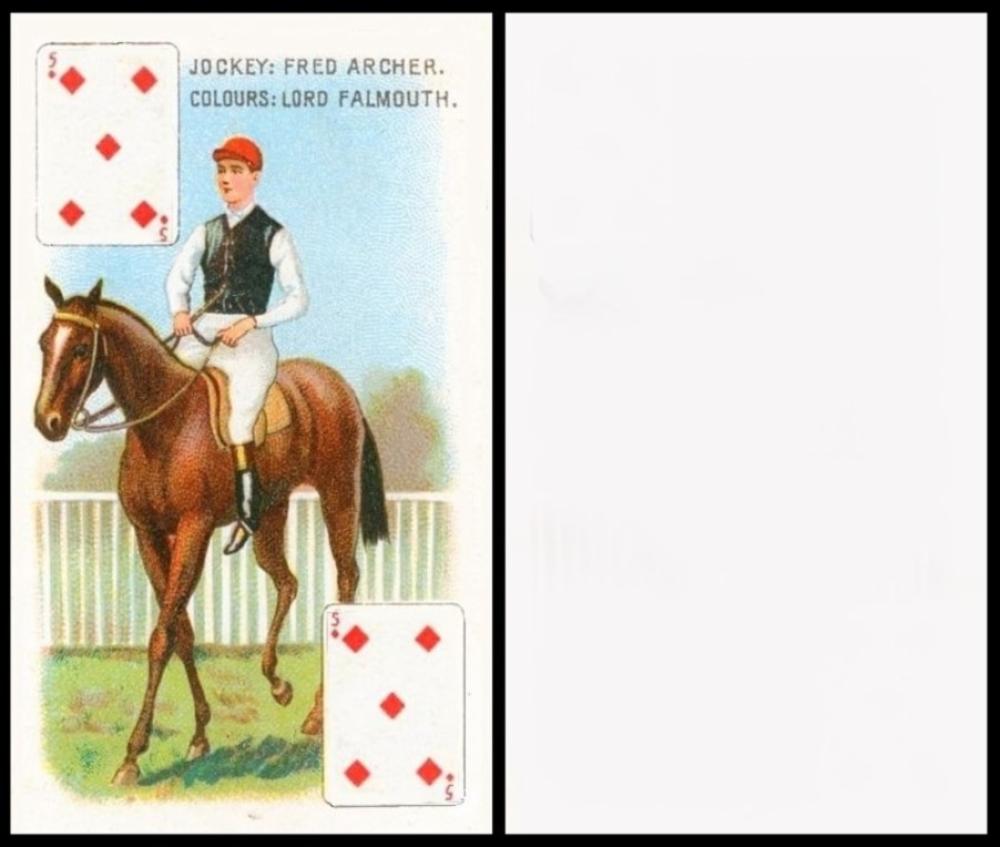
Anonymous / British American Tobacco [tobacco : O/S -] "Jockeys & Owners Colours" - untitled (1914) 5 Diamonds/53 - ZJ03-440 : ZJ3-48
We start our weekly adventures with the birth of Frederick James Archer, in Cheltenham, today, the 11th of January, 1857. We planned to have Pagets Awareness Day, but bones on cards seem few and far between, on sets we have not used before, anyway, so we went back and found Frederick "Fred" Archer, showing here
However, his story really starts with William Archer, born in 1826, who was also a jockey, and a really good one; good enough that, aged just seventeen, he left his home in England to become head jockey and stud manager for none other than the Tsar of Russia.
Now there seems a bit of fogginess over what happened next, some accounts say that he came back to ride in the Grand National of 1858, which he won, on a horse called Little Charley, and then he met his future wife, Emma Hayward, the daughter of a publican near Cheltenham. However that might not be true, because little Frederick, the man on our card, was already a year old when he won that race - though, as we all know, babies do not always wait until you are married. And, by 1861, there were other children, all squeezed into a tiny cottage, until, in that year, his wife`s father died, and left him his inn, or maybe just the tenancy of an inn. This was in Prestbury, the perfect location for William Archer, close to many racing stables and, more importantly, the home of many trainers and owners.
William Archer taught all his children to ride, on all manner of mounts, from carthorses to donkeys. Three of the children followed in his footsteps, and became jockeys, Fred, Charles, and William, who was sadly killed, in a fall, over the sticks, at Cheltenham Racecourse.
Fred was definitely the best rider, and when he was ten years old his father sent him to Newmarket as apprentice to the trainer Matthew Dawson. His first race was in 1869, and by the end of the year he had also had his first win. He also fell in love with the trainer`s niece, Nellie Rose Dawson, and they were married in 1883.
Though they were very happy, it did not last, their first son died at birth, in January 1884, doubly sad, as it had been planned to call him William, in honour of Fred`s much missed brother. His wife was also very sick, and it was feared she would not live. She did live, but was soon pregnant again, against the advice of the doctor; she gave birth in the November of the same year, to a daughter, called Nellie, but died shortly after, aged just twenty-three.
Fred Archer threw himself into his racing, and rode almost two hundred and fifty winners in the following year. In October 1886, he caught a chill, whilst competing, which led to a fever, and then to what is now thought to have been typhoid. Within the month he was dead, but not of the fever; he had shot himself, almost two years to the day that his beloved wife had died. He was not yet thirty years old.
His daughter went to live with her grandparents, but I have found nothing more about her.
The strangest thing of all is that I have only found this one card depicting Fred Archer. But maybe you know of others? It is also hard to tie this down to a specific race, or horse, because Evelyn Boscawen, Lord Falmouth, mentioned on the card, was the principal owner for whom he rode. and he may have been Lord Falmouth, but he had his yards in Kent. He started out using the pseudonym "Mr. Valentine", and he employed the Yorkshire trainer, John Scott. However, when John Scott died, in 1871, he sent his horses to a Mathew Dawson, at Newmarket, which is where he met Fred Archer, then his chief jockey. Within three years, Fred Archer was retained by Lord Falmouth, and over half of all his winning rides were under his employ.
As for those of you who are yelling, what about the card in Ogden`s "Steeplechase Trainers & Owner`s Colours", issued in 1927 (he is card 2/25), well, this is not our man - it is his nephew, also named Fred Archer, one of whose horses, "Double Chance", won the Grand National in 1925.
Our set is recorded in our original World Tobacco Issues Index as :
JOCKEYS AND OWNERS COLOURS (A). Sm. 63 x 38. Playing cards inset. (53). See W/249.B Issued abroad through B.A.T. ...ZJ3-48
It is the same text in our updated version, save a new card code, of ZJ03-440.
Curiously, though it was issued by British American Tobacco, it is not listed in RB.21, save as a title and date of issue in the index, and a link, once more, to W/249, the Wills version, which was issued in April 1914, and is recorded in the original World Tobacco Issues Index under section 4.G, that covering Export issues distributed with their "Scissors" brand, as : "JOCKEYS AND OWNERS COLOURS (A). Sm. 63 x 38. Playing-cards inset. (53). See W/249.A. ...W62-363". That too is the same text in our updated version, save a new card code, of W675-509
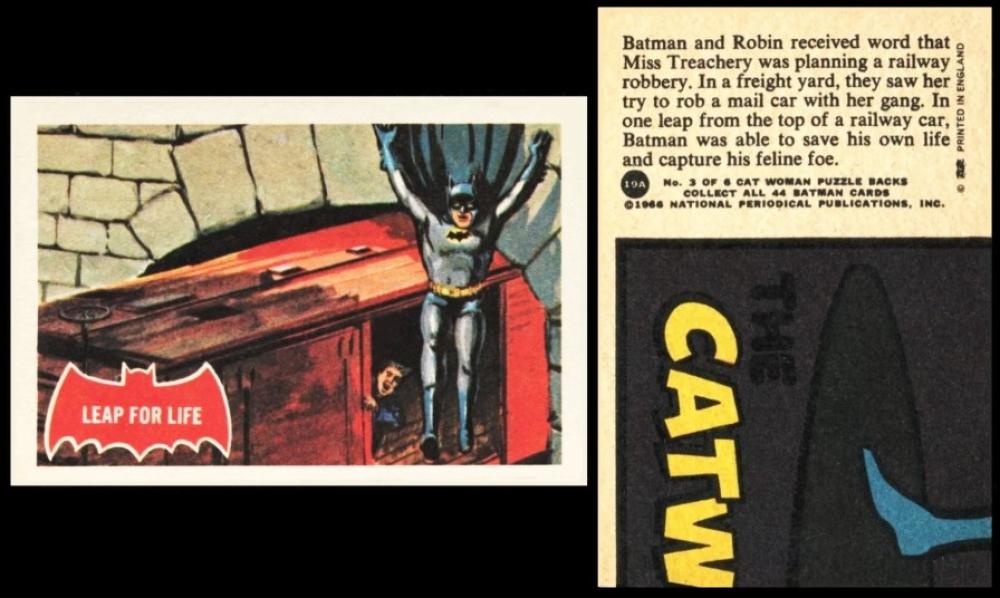
A. & B.C. Gum [trade : bubble gum ; UK] "Batman" - red bat, "A" suffix (1966)
This was the first day that caused all the trouble. It started out as the attempted assassination of Al Capone by the North Side Gang, which was the first time that Thompson sub machine guns were used by gangsters. However though there is a card of this weapon, as part of Parkhurst "Guns", I found nobody with one they wanted to share.
I then did a little digging, and found that today, in 1966, Batman aired on the American Broadcasting Company network, so we can fill a gap in our index and show you one of the "Red Bat" cards, which, rather neatly, was issued by another, homegrown A.B.C., that being A.& B.C. Gum.
Now originally, Batman was planned as a one hour show, and scheduled to start in the Autumn of 1966. However this was shelved, for all manner of reasons. All that was offered in exchange was to postpone it until January 1967, with another change, that being that A.B.C. had no space for an hour show and each episode would have be shown in two halves, over two different days. This did have an unexpected bonus though, as it created the opportunity for a cliff-hanger, a hark back to the early silent pictures, where a serial would end with a car, hanging over a cliff, and you would have to wait, sweating, until the next episode; and often, when that started, the car had miraculously managed to swerve out of danger instead.
This set is one of several known as the "Red Bat" versions, because on the front of the card the title is framed by a bat, coloured red. There were four "Red Bat" sets, the first having an "A" behind the number, the second using the phrase "Bat Laffs", the third having "Batman" in a bat, and the fourth having the picture in corner mounts and using the phrase "The Riddler`s Riddle". You can read all about these on our home page for the entire A & B.C. "Batman" sets, which is with our Card of the Day for the 15th of February, 2024
By the way, I did have a question about this card, but the Batman Forum answered it admirably. However I still have not encountered the phrase before, so maybe any Bat-Fans out there can let me know whether they have ever come across it elsewhere?
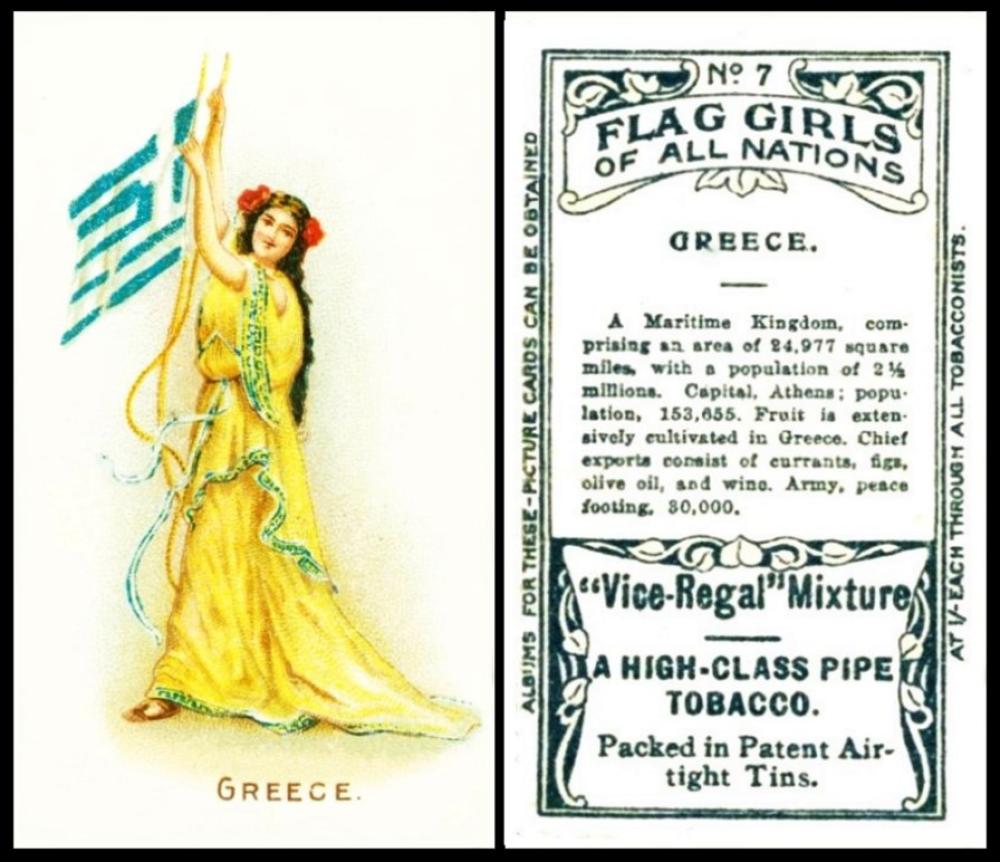
W.D. & H.O. WILLS [tobacco : UK/export - Australia] "Flag Girls of All Nations" (1908) 7/50 - W675-350.B : W62-223.B.2 : X.21/200-64.2
Today, in 1822, this flag was officially adopted by Greece, decreed by the First National Assembly at Epidaurus.
It looks quite a simple flag, but there are many theories as to why it looks the way it does.
The blue is universally regarded to represent the sea, or the sky, though it has become darker and lighter through the years. The white, however, is either thought to be the waves, the land, or the white houses which cluster on the hillsides above the sea. The cross is less debatable, and stands for the main religion of Greece, Eastern Orthodox Christianity. Blue and white are also the colours of this religion.
As for the number of the stripes, there is no official reason, but if you research it there is a belief that they are a reference to the motto of the Greeks who rebelled against their Ottoman oppressors, "Eleftheria i Thanatos", or "Freedom or Death", for there are five blue stripes for the syllables in the first word and four white ones for the syllables in the second.
There was an earlier flag, though, which came from Crete, and represented a noble family. Though no examples exist, it is said to have been blue and white, or blue and silver, with nine horizontal stripes and a cross. The family were sent to Crete by the tenth century Byzantine Emperor Nikephoros II Phokas, to whom they were related.Then they either moved, or were moved, to the Ionian Islands, which were then part of Venice but, in the mid nineteenth century, became part of Greece.
This set has many permutations, including other Wills versions, branded for "Scissors" and "United Service", and we have so far not featured any of them as a Card of the Day. We will do, and soon. For now though we will simply record the information for this version of the set, which appears first in our original reference books to the issues of W.D. & H.O. Wills, parts III (1949) and IV (1950). The first of these will be scanned in, for it also includes a table of the variations over the seven Wills issues.
However part IVs entry is smaller, being only relating to column "G", which reads :
64. FLAG GIRLS OF ALL NATIONS. - see page 102.
In the Australian issues "A" and "B", card no. 30 is found with caption on front (a) Sibiria (b) Siberia.
The anonymous plain-backed issue under "G" can be subdivided into two series of 25 : (a) large letter captions - subjects same as other 25 card issues listed on page 102 (b) small letter captions - balance of 25 subjects. Issued in Canada, see page 42, item C.91, of Mr. Burdick`s American Catalogue.
An issue by B.A.T. similar to this series and issued with "Motor" Cigarettes is now known
By the time of our World Tobacco Issues Index, the Wills versions are recorded as :
FLAG GIRLS OF ALL NATIONS. Sm. 63 x 36. Nd. (50). See W/64 and RB.21/200-64. Brand issues. 25 subjects with captions in (a) small (b) large letters, 25 with captions in medium letters - see X.21/200-64 ... W62-223
A. "Capstan" back
B. "Vice Regal" back
This is exactly repeated in our updated World Tobacco Issues Index, with one exception, for that is missing the X.21 code. The reason for that is that this code was printed in the handbook which accompanied the original World Tobacco Issues Index, at first as a separate hard backed book, and then, in the reprint, was combined as one volume beneath the same covers. The entry, in both versions, reads :
X.21/200-64 FLAG GIRLS OF ALL NATIONS. There are two printings of the Wills Capstan and Vice-Regal numbered series as follows :
1. 25 cards numbered 1-5, 11-14. 18-21, 28-38 and 50 with captions on front in lettering all the same size (a) small letters about 1 1/2 m/m high (b) large letters about 2 m/m high. Printing (b) has the error card "Sibiria" at No.30.
2. 25 cards numbered 6-10, 15-17, 22-27, and 39-49 with captions on front in medium size lettering with the first letter about 2 m/m high, remaining letters about 1 3/4 m/m high.
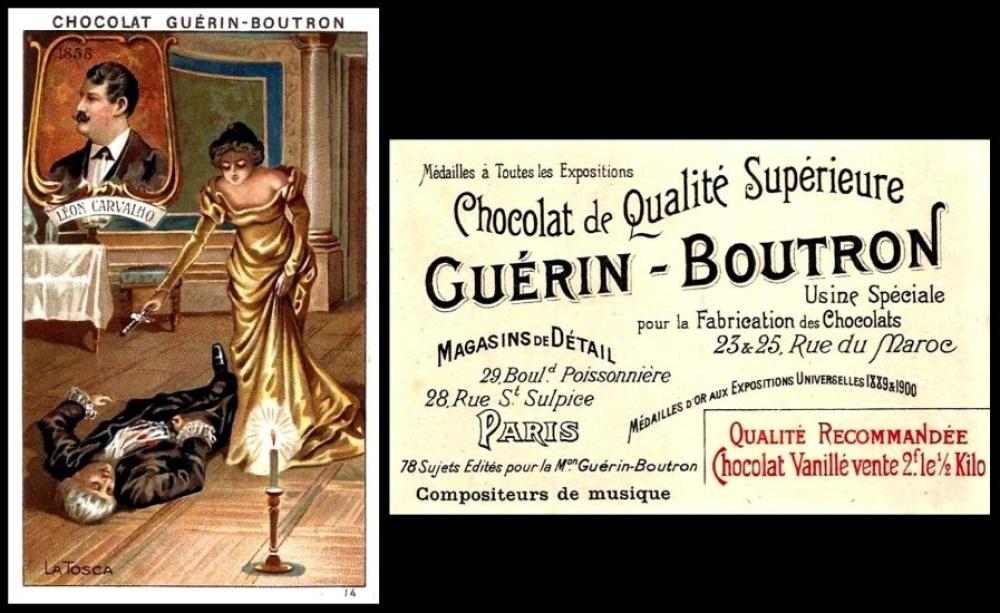
Guerin-Boutron [trade : chocolate : O/S - Paris, France] "Compositeurs de Musique" / "Composers and Music" (1905) 14/78
This was the second day which held me up. At first it was pencilled in as Marilyn Monroe marrying Joe di Maggio, but we have featured him before, or so I thought, but I could not find it. It then changed to the launching of RMS Oceanic, in 1899, which was on a Guinea Gold, or at least the RMS Oceanic was, but when I tracked that down it was on one of the Guinea Gold versions we have featured before. That left a big blank.
However it is now filled, with the premiere of an opera, today in 1900, by Giacomo Puccini, called "Tosca", at the Teatro Costanzi in Rome.
And our card shows almost the same picture as was used on one of the posters, namely Floria Tosca, who was a famous singer, and Baron Scarpia, the chief of police, who tried to seduce her, and instead was slain. Actually "Tosca" is a very odd opera, full of death and murder, hardly a fun night out at the opera, though it is ostensibly a depiction of what would happen if Napoleon had invaded Italy a hundred years before.
In fact Puccini took the idea of the opera not from his head, but from a French play, called "La Tosca", written by Victorien Sardou just three years earlier, and which was staged with Sarah Bernhardt in a leading role. It was extraordinarily popular, and Puccini saw it several times. He also asked his publisher to contact Mr. Sardou and ask if he could convert the play into an opera. Mr. Sardou was not so keen on this, he liked the idea of his work being an opera, but he hoped a fellow Frenchman could do it, rather than an Italian. There were all kinds of back and forths, ending with Puccini pulling out of what was, at best a very speculative agreement. Then he wanted back in, by which time someone else had taken the job. He then lambasted this other writer, and it is said he convinced him that it was not a good story, too violent, and he would certainly be mocked for his ever attempting to make what would undoubtedly be a failure. One of these thoughts must have struck home, and the writer wavered, on which Puccini jumped immediately in and took over, that was in May 1895.
It was successful, and moved, quickly, to La Scala. And it still remains a favourite today. Through the years it has also featured the very greatest of stars in the lead, Enrico Caruso, and Maria Callas, but not, of course, together.
It is still an odd subject though, or so I think...
And there is another curious thing, because the man in the inset miniature to the front is not Puccini, it is Leon Carvalho, who seems to have no connection with either Puccini or Tosca - unless you know of one
Now this is another of those long sets by Guerin-Boutron and there will, one day, be a list. However there is not time to attempt it yet, more than the first one, which is :
- Mercadante : 1796 - 1870 : "Horace"
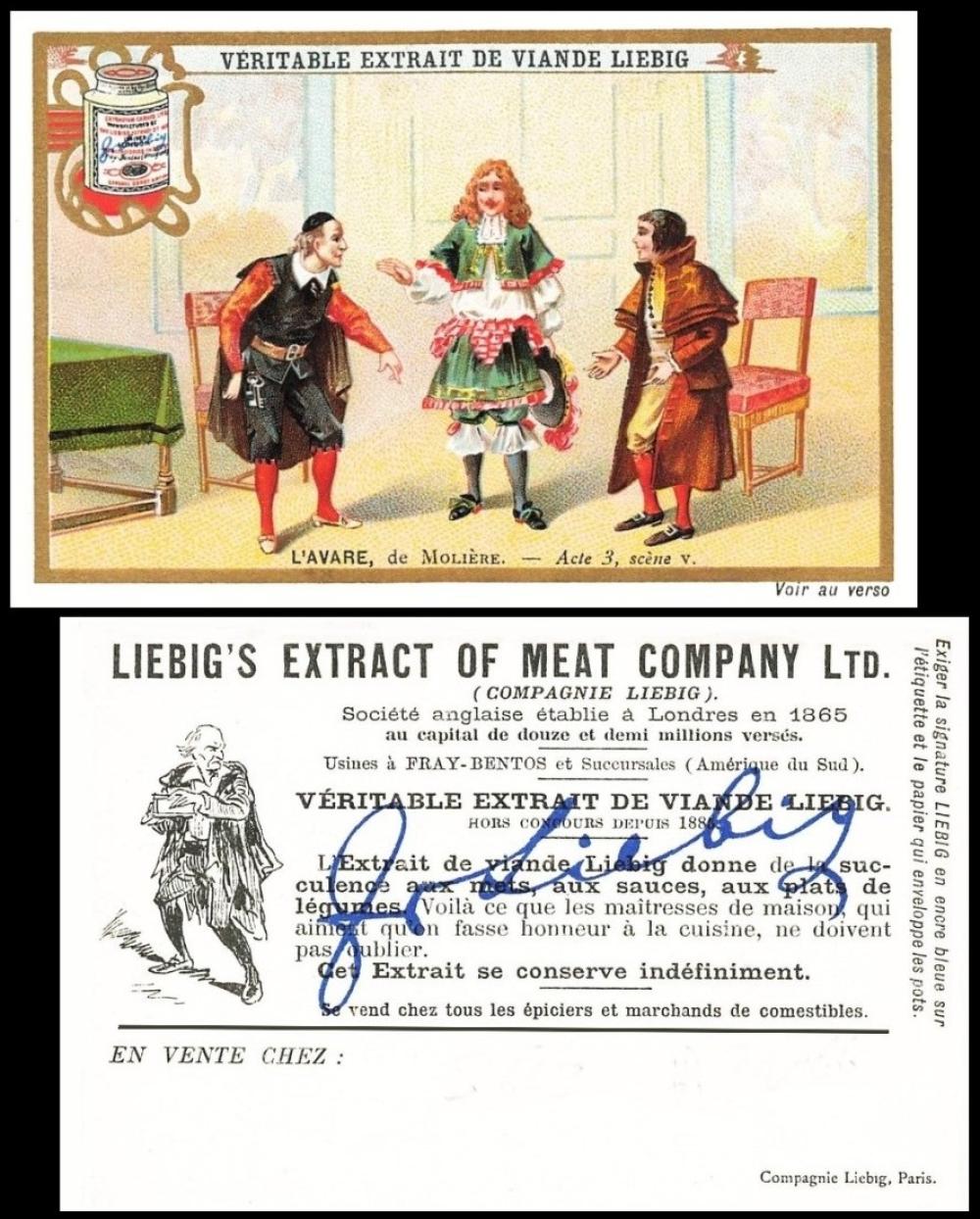
Liebig [trade : meat extract : O/S - South America] "Comedies d`Auteurs Francaises" / "Productions at the Comedie Francaise" (1901) Un/6 - F.0662 : S.0663
Today, in 1622, Moliere was baptised, though you will often see it given as his date of birth. This does not mean that he was born on that day, and hurriedly baptised, though when the child is sickly, this can happen; for the most part, and especially in rural areas, where things like dates were not so vital, babies were born, and as long as they were baptised by the Sunday that followed their arrival it was okay. It was only later that baptismal records started to show the date of birth and the date of baptism. Younger readers may find it amazing that when I was born, in the 1960s, a hospital still only showed the time of birth on the certificate if it was a multiple birth, twins, triplets, etc. Otherwise your parents just remembered the time you were born; or not...
Curiously, the man we know as Moliere was actually born Jean-Baptiste Poquelin, in Paris. His parents were reasonably comfortable, financially, but his mother died when he was ten and he was sent away to school. It seems that his father had little time for him, and seems to have been chiefly interested in social advancement, he had fairly recently begun working for the King, as "keeper of carpets and upholstery", kind of an interior designer, we would say today, but tellingly he had bought this job, rather than been chosen on merit. He also wanted his son to study law, and even chosen the school he went to because it was almost guaranteed to bring him into contact with several members of French nobility.
Our man was not too interested in this side of life, but he did enjoy one of the extra-curricular activities, which was the theatre. Here, he discovered a flair for acting and writing, so much so that in 1643 he decided that he wanted to take it up as a career. Apparently this was not to his father`s liking, and it caused a separation. Our man was friendly, to say the least, with a woman called Madeleine Bejart, and the two of them teamed up to set up their own theatre. She was four years older than him, and already famous, though her beginnings were far humbler than Moliere`s. She was to act, and he was to write the plays, which her sister and brother also took part in.
The troupe then fell on hard times, began to miss rent payments on the theatre, and, in 1645, it went bankrupt. Our man even went to jail, overnight, before someone stepped up and paid the money they owed. There are several theories as to who this was, it seems unlikely to be his father, for many reasons, not least of which is the fact that once released our man abandoned his family name forever and took the stage name of "Moliere".
Now his female friend was a very interesting lady, and could have had her pick from many lovers, but it seems that her torch was lit for Moliere alone, and also that this was frequently reciprocated. However, as she grew older she retired gracefully and let others take the leading roles. In 1662 she even allowed Moliere to marry, her daughter, Armande, who had been born in 1643. There seems no record of who was the father of this daughter, but it was obviously not Moliere; some say the child was from a fellow actor, whilst others say she was of Royal birth, presumably Louis XIV, who may have paid their theatrical dues, and who also seems to have had a lot of interest in Armande and her subsequent children with Moliere.
The third of these children was born in 1672, and died shortly after. Moliere was showing signs of ill health too, which we now recognise as tuberculosis, and even attribute to his time in jail, plus the stress of the failing theatre. And on the 17th of February, 1673, he collapsed on stage, amidst a fit of coughing. suffered from pulmonary tuberculosis, possibly contracted when he was imprisoned for debt as a young man. He was escorted home, but died a few hours after. His death led to the legend, common amongst actors, that to wear green, on stage, is unlucky.
Worst of all, because he was an actor, he was not permitted to be buried in sacred ground, so his wife went to the King, (which again proves there was some kind of connection there), and the King arranged that Moliere could be buried overnight, in the plots which were set aside for unbaptised infants. He was then dug up in 1792, and his remains moved to a museum, from where they were removed and reburied, at Pere Lachaise, in 1817.
Now this set of cards celebrate the Comedie Francaise, or, more correctly, the Societe des Comediens-Français, which was founded in 1680, by the merging of Moliere`s own troupe, and the Theatre du Marais. They continue to perform his works, including the one shown here, L`Avare, or The Miser, first performed in September 1668. The man in the centre is thought to be Moliere, but the green coat is not the fatal one, for this is a different play.
The other plays shown in this set are :
- Frou Frou, by Meilhac and Halevy
- L`Ami Fritz, by Emile Erckmann & Louis Alexandre Chatrian
- Le Bourgeois Gentilhomme, by Moliere
- Le Monde ou L`on S`Ennuie, by Pailleron
- Les Precieuses Ridicules, by Moliere
Moliere also features on several other Liebig sets, as well as many French chromos.
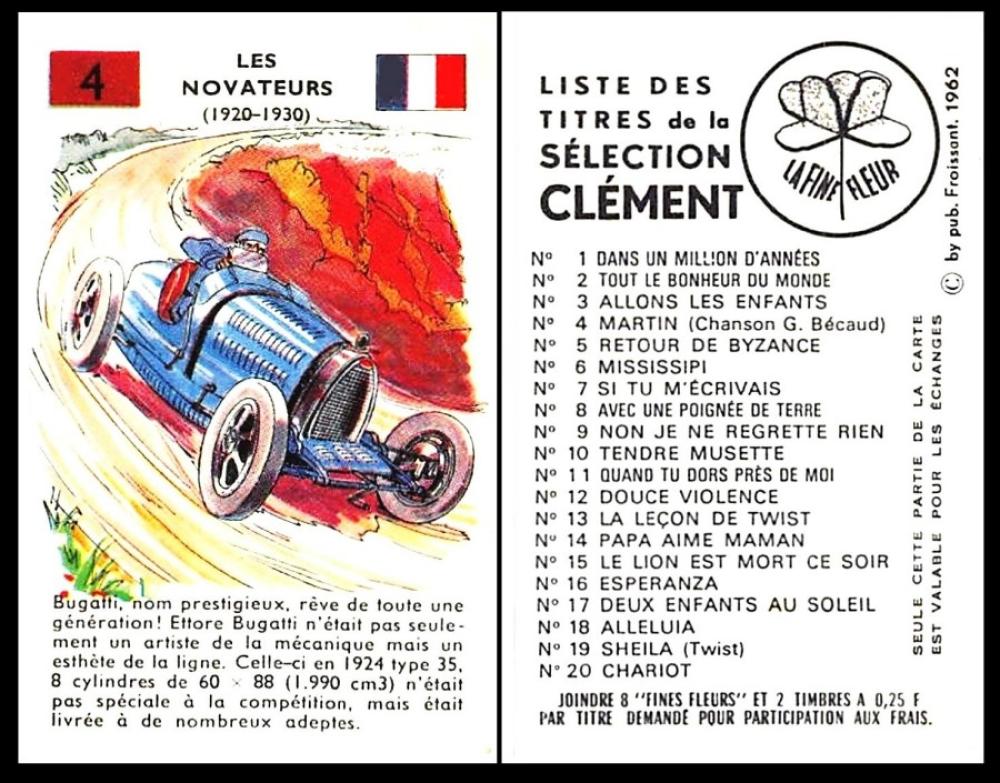
Biscotte Clement [trade : French Toast : O/S - France] "Voitures Anciennes" / "Historic Vehicles" (1962) Les Novateurs card 4/6
Now this is a fascinating tale, for today, in 1903, William Charles Frederick Grover was born, in France, to a French mother, but an English father, who was out there in connection with his love of horses and his skill at breeding and training them.
When the First World War broke out, the young boy was sent to England; afterwards the family relocated to Monte Carlo. This was a place full of amazing cars, and William much preferred horse power of that kind, and so, as soon as he could, he started learning to drive, though it appears he started with a motorbike. He had many adventures, over all kinds of terrain, and he loved speed. This led to him holding the honour of becoming the first ever Monaco Grand Prix winner, in 1929, driving a Bugatti Type 35.B, the type showing here; though this is Ettore Bugatti at the wheel. Our man actually bought his vehicle himself, and entered as a privateer, not as any official Bugatti entry. To make this clear he also painted his car green, in the shade which became known as British Racing Green.
He may have won the Monaco Grand Prix, but he had won the French Grand Prix, two years in succession. In all his races he competed under an alias, W. Willliams - sometimes it is said that he was such a keen competitor that the alias was to save himself embarrassment if he did not win. However, it is also said that he liked playing at being someone else, without anyone finding out it was him.
His love of adventure led to him taking more and more risks, and when the Second World War broke out he joined the Special Operations Executive, which sabotaged and spied on the German forces, in conjunction with the French Resistance. In August 1943 he was captured, and taken to a prisoner of war camp, where he was executed in March 1945.
Now this is where the story takes a strange turn, as there are not only varying dates for his execution, but also several reports that he survived, took a false name, George, or Georges, Tambal, which would definitely have been something he would have enjoyed, as with his racing alias. Tambal means a drum, specifically a kettledrum, and I am certain if I play with that long enough I will get somewhere with a link to aliases and spyings. He also reputedly returned to his wife, a former artist`s model, who by that time was a dog breeder, in Normandy. Unfortunately, she died not long after, in 1948. Georges Tambal lived about thirty more years, but he was killed, in either 1973, or 1983, there are even varying stories there, by all agree that he was riding his bicycle,and struck by a German tourist. If you want to know more, there is an excellent account of his life at The Scotsman/WGW, and very well researched.
As far as our card, I knew very little, but am piecing it together, slowly, with help from our readers. We have now changed the title, it is "Anciennes Voitures", or Historic Vehicles, and that explains why they date from "before 1890" only until 1940. I originally suspected that there was a later groups still to find.
The biggest discovery came from Mr. Parker, who spotted that though "La Fine Fleur" means `the rose maker`), if you look closely at the rose on the symbol it is made from slices of bread - this led to the discovery that it is actually French Toast, sold, to this day, in packets, under the name "Biscotte Clement".
These flower symbols had to be collected, and when you had eight, plus a .25 franc stamp, you could exchange them, though I am totally baffled at how this exchange operated, because there is no address on the cards - unless you took them to a shop. Also when I originally wrote this I thought the titles were books, but they are to be records, released in France in the 1950s and 60s. I do not know yet what the link up is with the records and the bread.
I also know, now that I have seen more cards, that ours is trimmed - originally they were issued in strips, at least three cards wide, because some of them have perforations along the sides.
What follows is a list of all the cards found so far - at first it was very confusing, as the same number appeared on more than one card, but eventually I twigged that there were subsets, named in bold below, and each of those had six cards, not all of which I have yet found.
Les Precursors (avant 1890) -
- Cugnot (France)
- Diligence a Vapeur (Great Britain)
- Voiture Delamarre et Boutville (France)
- La Mancelle d`Amedee (France)
- Les tricycles motorises (Germany)
Les Inventeurs (1890-1900) -
- Panhard Levassor (France)
- Albert de Dion (France)
- Voiturette Delahaye 1898
Les Ancetres (1900-1905)
- Baron P. de Crawhez (France)
- Gordon Bennett (Great Britain)
- Tom Fetch, Packard (USA)
Les Vulgarisateurs (1905-1910)
- Cadillac (USA)
- Peugeot (France)
- Ford Model T (USA)
- Suisse (Switzerland)
- Rover (Great Britain)
- Peugeot (France)
Les Promoteurs (1910-1920)
- Berliet (France)
- Rolls Royce Silver Ghost (Great Britain)
- Bebe Peugeot (France)
- Coupe des Voiturettes, Boulogne (France)
- Grand Prix de l`ACF (France)
- Cadillac 36 CV (USA)
Les Novateurs (1920 - 30)
- Premier voiture Citroen (France)
- Citron (France)
- Le Torpedo Sport Voisin
- Bugatti (France) - our card
- Hispano Suiza (Spain)
- Lancia Lambda (Italy)
Les Realisateurs (1930-1940)
- Emile Mathis Bugatti (France)
- Citroen (France)
- Rolls Royce (Great Britain)
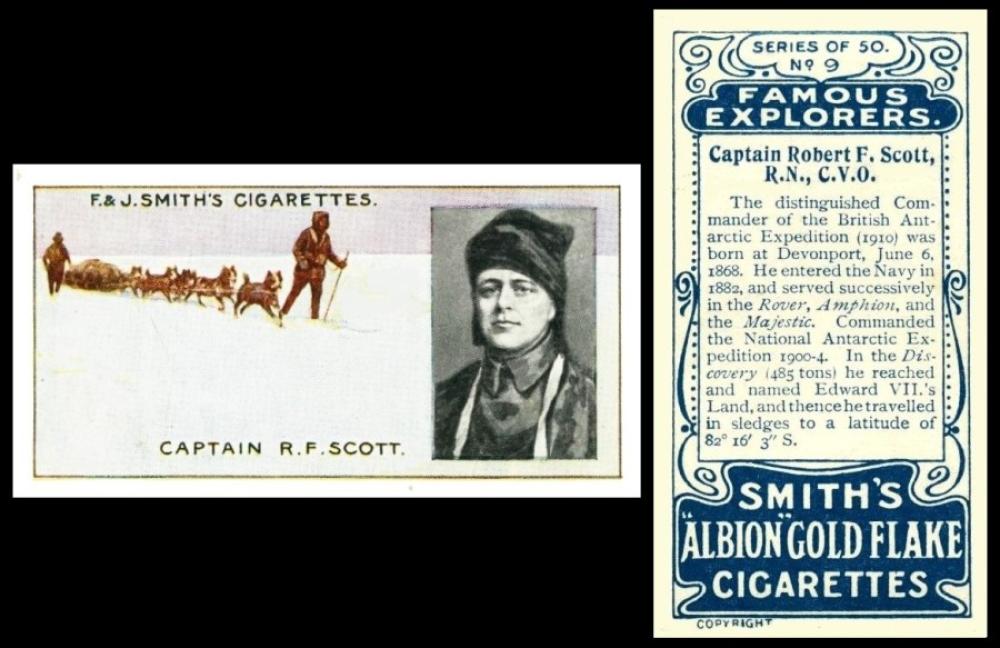
F. & J. SMITH [tobacco : UK - Glasgow, Scotland] "Famous Explorers" (October 1911) 9/50 - S548-180 : S84-7
Today in 1912, Captain Robert Falcon Scott reached the South Pole, five weeks after the flag had been planted by Amundsen.
Captain Scott was not just an explorer, he was an officer in the Royal Navy, and he had been born in June 1868. He had form for he had already led an expedition to the Antarctic, aboard the Discovery, between 1901 and 1904. During that he had actually discovered the Antarctic Plateau, on which the South Pole was located.
The expedition on which he went further and discovered the South Pole started in 1910. It is known today as the Terra Nova Expedition, from the name of his ship. Before it started there was controversy, for Ernest Shackleton had announced that he too would be attempting to reach the South Pole. Captain Scott attempted to stamp this out, even going as far to stake a claim to the whole area around the Ross Sea.
Captain Scott`s journey to the Pole was arduous, but successful, however, on the way back things went badly wrong, and this was only found out when he failed to turn up at a meeting point. Then the search was on, and they found the bodies of Captain Scott and his men. However they could only estimate when they had died, for many reasons, not least the fact that the weather had taken a terrible turn for the worst and reached minus 40 °C.
There are quite a lot of cards which show the expedition, which really captured the feeling of the time. Chief amongst these is the Fry's Cocoa set of "Captain Scott at the South Pole", which we featured as our Card of the Day on the 9th of October 2023. Another important set is Cadbury`s "Antarctic Series", which we featured as our Card of the Day on the 6th of July, 2022
Our card is thought to be his "Rookie" card, but we know that he appeared on a card by Felix Potin, albeit as part of the third series. If a Potin collector can supply a date of this, we would be very interested.
As far as this set, we have already featured it as a Card of the Day, on the 24th of September, 2024, this being the home page to which all the different backs link back to. That also includes the chart, extracted from a "Cartophilic World" magazine that was originally published in 1945, that shows which brand was advertised on each card - ."Albion Gold Flake" being on cards 1 to 10 inclusive.
Smith`s "Albion Gold Flake" were cigarettes, and they came in packets of ten, printed in red on a yellow, or probably gold, background. They were marketed as being "Rich and Cool". Curiously, a lot of other companies also had a "Gold Flake", most notably W.D. & H.O. Wills, whose packet was also yellow.
This week's Cards of the Day...
have been remembering. and celebrating David Bowie, one of my all time favourites. He was born on the 8th of January, 1947, in Brixton, London, and died on the 10th of January, 2016, in New York.
He was a master shapeshifter, with several stage personas, and a great inspiration to those of us who did not feel we fitted in to the life in which we were born. He showed us that we could change, and explore different ways of being, and that, somewhere, out there, were people, just like us, our tribe, with whom one day, with luck, we may connect...
Saturday, 4th January 2025
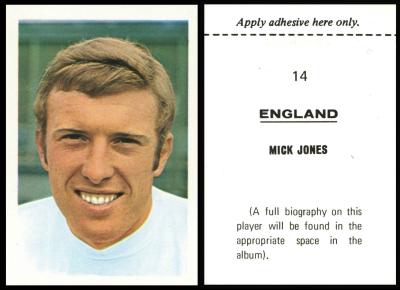
This card refers to the surname, "Jones", which was the real surname of David Bowie, born David Robert Jones. In fact when he started out he did try to use David Jones, but the name was too similar to the Monkees` Davy Jones, born David Thomas Jones, in Manchester, in 1945.
There is also a link with the "Mick" part, as the guitarist of David Bowie`s "Spiders From Mars" band was Michael "Mick" Ronson
This set is usually known as "Mexico 70", but it has another title, of "World Cup Soccer Stars". And, in fact, the album is titled "World Cup Soccer Stars - Mexico 70".
The cards were issued to commemorate the World Cup of 1970, which, as you all know, was the one which we hoped to defend, after our win in 1966. It is almost certain that this was why the stickers were produced, for the entire thirty strong England Squad are shown, and only sixteen for each of the other countries
Unfortunately this was not to be the case, and Brazil won, 4–1, against Italy - a notable match, for it was the first time that both protagonists had won the cup before, Italy`s former victories being in 1934 and 1938, whilst Brazil`s were more recent, being in 1958 and 1962. West Germany was third, and Uruguay fourth. England was knocked out in the quarter finals, beaten 3-2 by West Germany, in a complete reversal of the 1966 result. West Germany were then beaten by Italy to make one half of the final.
Now we know that the stickers came in a packet of seven, and each packet cost 6d. The albums cost an extra two shillings and sixpence, and the cards still had to be fixed in by gluing, this was before the days of the peel and place. If you failed to complete an album, you could order the stickers you lacked from F.K.S, but only up to December 1970.
Now some collectors swear that this set was available much earlier, but that does seem an awfully long time to allow for completion. However they do have some supporting evidence, for the album, printed in Spain, gives a copyright date of 1967.
Sadly, F.K.S. ended up going bankrupt in the late 1980s.
F.K.S sets are listed in our British Trade Index part III, starting with the 1968 set of "The Wonderful World of Soccer Stars" and ending with the 1982 sets of "Spain 83" and "Nasties", which was prepared for issue but never actually was. This seems to be regarded as their final issue, and no more appear in our British Trade Index part IV. But if anyone knows of later sets do send them along.
Our set is described as :
1970-1 Mexico 70 (A). 72 x 49. Nd. (272). Anonymous, back style as Fig.FAA-2 ... FAA-3
The back at FAA-2 was used from 1968 until 1971 on four sets, "The Wonderful World of Soccer Stars" (1968), "The Wonderful World of Soccer Stars in Action" (1969), our set "Mexico 70" (1970) and "Soccer Stars - Gala Collection" (1970). There was a different back on the set which follows, "The Wonderful World of Animals" (1971)
In our updated British Trade Index, no sets are listed, only this :
F.K.S. Publishers Ltd. London
Commercial issues, cards sold in shops, in packets of five to ten, 1968-70, post 1970 issues mentioned in post-1970 volume. No details listed in this volume.
Sunday, 5th January 2025
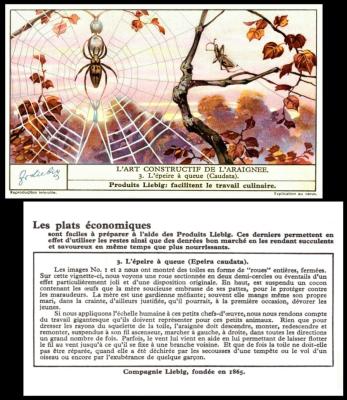
This card stands for that very David Bowie`s backing band in the 1970s, "the Spiders from Mars", which included Mick Ronson, mentioned above, and Mick Woodmansey, both of whom had been in an earlier band put together by David Bowie. Their fame was sealed with the 1972 album "The Rise and Fall of Ziggy Stardust and the Spiders from Mars", Ziggy Stardust being the alter ego of David Bowie.
There was also a world tour, which started in Aylesbury, went to America and Japan, and ended at the Hammersmith Odeon, on the 3rd of July, 1973, when David Bowie announced it was the last show of the tour, and the last the band would ever do.
This set is much more modern-looking, especially to the back, than many of the Liebig cards we feature, for it is simply text, there is neither an image to one side, nor a large signature across the back, this having been miniaturised and moved to the front in the small box at the bottom on the left hand side.
The full set shows six different spiders
- L'epeire diademe (Araneus diadematus) - the European Garden Spider
- L'epeire a cornes (Epeira cornuta) - the furrow spider
- L'epeire a queue (Epeira Caudata) - the long horned orb weaver
- L'agroeca brune (Agroeca brunnea) - the fairy lamp spider
- L'araignee tapissiere (Cteniza fodiens) - trapdoor spider
- L'argyronete (Argyroneta aquatica) - the diving bell spider
It was issued in several languages, Belgian (as "Art Constructif de l`Araignee), German (as "Baukunst der Spinne"), Italian and Swiss (both as "l`Arte Construttiva del Ragno") and in Dutch (as "de Bouwkunst der Spinnen").
Most of these versions can still be found easily, and cheaply, at well under £10, though you may be asked slightly more for the German set.
Monday, 6th January 2025
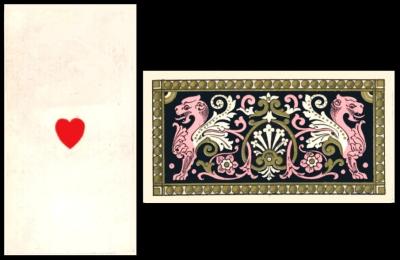
This card has three important connections with our theme. It is a "Thin", narrow card - it is primarily "White" in colour - and it was issued by "Duke".
These three words give us the very different persona which replaced "Ziggy Stardust", namely "the Thin White Duke". He was extraordinarily thin, and his orange hair made his face appear washed out, but in a good way. There was also a definite touch of the other world.
This character appeared at around the time of David Bowie`s "Young Americans" album, released in 1975, and there is almost certainly a connection to his very similar appearance in the science fiction film "The Man who Fell to Earth", released in cinemas in 1976.
This set was first listed by Jefferson Burdick in his "American Card Catalogue", as :
84 Playing Cards (53) double lion backs
a) with symbols in diagonal corners (Duke`s Cigarettes)
b) without diagonal corner symbols (Turkish Cross Cut)
He values them, all, irrespective of whether or not they have symbols, at twenty five cents a card.
It is next listed in our World Tobacco Issues Index as :
PLAYING CARDS (A). Sm. (53). "Double Lion" back. Firm`s name on Ace of Spades and Joker, other cards anonymous. Front (a) with (b) without symbols in diagonal corners. See X2/84. Ref. USA/84 ... D76-33
This is pretty much what Jefferson Burdick wrote, with the addition of the part about the Ace of Spades and the Joker. It also copies the identification of the mythical figure on the reverse, and continues to call it a "double lion", though I think it is much more like a gryphon than a lion After all, in dictionaries of mythology, a gryphon, o griffin, is described along the lines of either being a lion, with a bird`s head, wings, and legs, and prominent talons - or a lion for the most part, apart from having an eagle`s head and wings.
The listing of this set is slightly altered in the updated version of this book, to read :
PLAYING CARDS (A). Sm. (53). "Double Lion" back. Firm`s name on Ace of Spades (which varies between printings) and Joker, other cards anonymous. Front (a) with (b) without symbols in diagonal corners. Ref. USA/84 ... D900-310
You can see an Ace of Spades and a Joker online, courtesy of the Metropolitan Museum of Art, New York. Note that below the circular stamp for the museum is also stamped "Gift of J.R. Burdick". That Ace of Spades is the one which advertises, in three lines, "DUKE`S / CIGARETTES / ARE THE BEST" around the top of the spade - whilst the one not shown reads, also in three lines, "TURKISH CROSS-CUT / CIGARETTES / ARE THE BEST".
As far as "the symbol", this appears to the top left and bottom right, and, in the larger denominations, it means that the pip at the top left is only half complete, for there is a number, the number of the card, and a tiny symbol which is the same as the suit. In the case of the court cards it makes it appear like the frameline in those corners is missing.
By the way, do be aware that an awful lot of sets being sold online are marriages, and if you look closely you will see that some of the cards have the symbol to the side and others do not. Always check the cards, and a reputable seller will always be kind if you ask them to see better pictures.
Tuesday, 7th January 2025
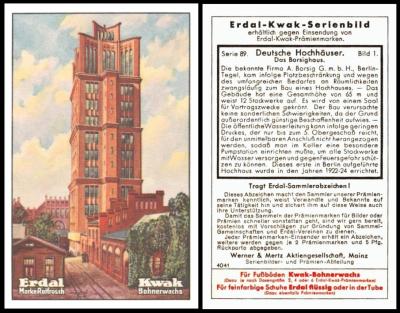
This card may seem out of place but it is the Borsigturm, or Borsig Tower, in Tegel, Berlin, and since it was built, in 1925, it has dominated the skyline across the Tegel area. Actually it was built as part of the August Borsig Locomotive Works, which it is often said were bought out in the early 1930s by AEG - the truth, though, is that on the death of August Borsig the works had passed to his son, who was not so well equipped to deal with the effects of the Great Depression, leading to the bankruptcy of the firm. At this point it was picked up by AEG, and they moved the train making to their own factory, at Henningsdorf.
As far as our theme for this week, after filming for "The Man Who Fell to Earth", David Bowie moved to Los Angeles, and found it hard to stay away from all kinds of temptation. He decided to move, and decided on Europe. In 1976, with his wife, he moved to Switzerland. In August 1976, but soon after relocated to West Berlin, with a friend, fellow musician Iggy Pop.
Both immersed themselves in the local music, and this resulted in three albums, "Low", "Heroes" and "Lodger", which today are collectively known as the Berlin Trilogy. They are quite experimental, with shattered fragments of songs woven in, even parts of his former songs but played backwards, something which seems to suggest his own state of mind at that time.
The two friends roomed together part of the time in Schoneberg, moving in and out, until one day they broke up. Both also visited other places, flying in and out of Tegel Airport. It is impossible that they would not have spotted this building as they flew, and they would almost certainly have admired the way that something which by then was fifty years old could look so modern.
In 1987 David Bowie returned to West Berlin, still a divided city, and held a concert right in front of the Reichstag. The location was no accident, and he hoped that it could be heard across the wall in East Berlin, which, with the amps ramped up to maximum power, it could.
His final performance in Berlin, by then one city again, was in November 2003, at the Max-Schmeling Halle, as part of his "A Reality Tour", named after his 2003 album. It was a massive tour, visiting almost every part of the globe, and playing over a hundred shows. However in June 2004 he had a heart attack, and the tour was cut short. He planned to return, but in 2006 he was advised not to tour, or to perform live, again.
This set is fascinating, and I have never seen it before. The other cards are :
- Das Borsighaus (1925)
- Die Grossmarkthalle Frankfurt a. M. (1928)
- Das Kölner Hochhaus (1925)
- Das Chile-Haus, Hamburg (1924)
- Wilhelm Marx-Haus, Dusseldorf (1924)
- Hochhaus des Hannoverschen Anzeigers (1928)
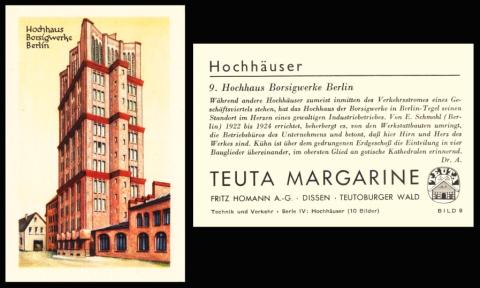
Now our building is quite a famous one, as it also appears as card number nine in another set of high buildings , "Hochhauser", issued by Fritz Homann with Teuta Margarine. And, many thanks to Stuart Arnold, who supplied this scan, we can see it for ourselves. Now this set is much more comprehensive, and includes not just German buildings, but ones from right across the world, including the Tower of Babel.
He also adds some info about Teuta Margarine, and Fritz Homann, of Dissen. Now Dissen is in a place called Teutoburger Wald, or the Teutoburg Forest, and that is famous as being the site of a great battle, which is also known as the Varus Disaster. This took place over three days in September, the 8th to the 11th, in 9 A.D., between the attacking Roman forces and the native German ones. In fact the Germans had set up an ambush, and they fought off three legions of men under the charge of Publius Quinctilius Varus, hence the alternate name of the Varus Disaster. The Germans were led by a man called Arminius, or in some reports, called Hermann the Cherusker - and to explain that, it seems like Hermann was the Germanic way of pronouncing Armin [ius], and he was a Chieftain of the Cherusci tribe - however there was something very unusual about him, for he was a German who had not only taken Roman citizenship, but had received Roman military training, which he then used to defeat them in his former homeland. And it was such a rout that the Romans abandoned any plans to press on into Germany.
What I do not know is whether something happened that altered the feelings of Arminius towards Rome - or whether it was all an elaborate plan because he felt so certain that one day the Romans would be coming for Germany.
Returning to the margarine, the brand name of "Teuta" is almost certainly a double salute to the area of Teutoberg, and maybe even a celebration and a memory of the grand battle The company also had other margarines - "Frihodi", which came from FRItz HOmann DIssen - "Homa", from the first four letters of his surname - and "Fri-homa", from part of his first and second name.
Now "Fri-Homa", whilst not issuing cards, did issue small white plastic models, in various series, and you can marvel at those courtesy of Mokarex/Fri-Homa
Wednesday, 8th January 2025
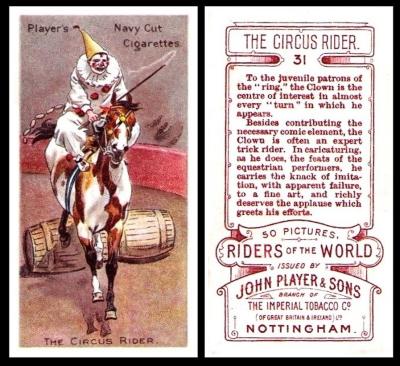
In 1980, David Bowie recorded a song, and music video, called "Ashes to Ashes", in which he again referenced a character from his past, Major Tom. You can see it online, at YouTube/ATA, but before you settle down, hear this - when it was made, it was the most expensive music video ever made, costing approximately a quarter of a million pounds. And it took three months to record.
The 1980s were good times for David Bowie, with three number ones, including this song, and another, which saw him singing with Freddie Mercury and Queen. He recorded his best selling single ever, "Let`s Dance", released in 1983. He started a new band, "Tin Machine". And he resumed his acting career, with intriguing, and sometimes controversial performances, playing Andy Warhol, extremely well, in the life story of Jean-Michel Basquiat; Nikola Tesla in "The Prestige"; and appearing as an F.B.I. Agent in David Lynch`s big screen version of Twin Peaks. "Fire Walk With Me".
For much of the "Ashes to Ashes" video, David Bowie appears, in a kind of repeating dream sequence, as a sad, white faced clown, and, for some reason, this card always makes me think of that. I don`t know why. Maybe you will also agree. It may be that the clown on this card is not just sad, but malcontented with his lot, for the back description tells us that he"...is often an expert trick rider..." and so perhaps he feels that if he could only be spotted by a random talent scout, he would be a big star in the movies, just like "Broncho Billy" Anderson..
I like this set very much and cannot believe that it is its first appearance on our site. You will see it again, too, for it has several variations. And, fittingly, this version was first issued in this month, a hundred and twenty years ago.
Our set was first recorded in our original John Player reference book, RB.17, published in 1950, as :
167. 50 RIDERS OF THE WORLD. Small cards. Fronts in colour. Backs in brown, with descriptive text. Home issues.
A. Thick grey card – Issued January 1905
B. Thinner white card – Issued August 1911.
Variety : Card No.35 [Jack Ashore] is found with “Player`s Navy Cut Cigarettes” on front in (a) one line (b) two lines
Similar series issued by Ogden, Wills, and United Tobacco Companies, South Africa
It does not mention anything about our British American Tobacco Booklet here, the home of all overseas cards like these - and the reason for that is that this was RB.21, which did not appear for another two years. When it did, the set was listed as
200-93. RIDERS OF THE WORLD. Series recorded in W/93, RB.15/146, RB.17/167 and H.358. All known printings are summarised below -
A. * Composite Wills` Australian issue, Nos 1-17 Capstan, Nos 18-34 Vice-Regal, Nos. 35-42 Pennant, Nos 43-50 Wills`s Specialities
B. * Wills` Havelock issue
C. Wills` Overseas issue
D. Anonymous issue, with letterpress on back, "C.T. Ltd" at base
E. Ogden`s Polo issue. See RB.15/146, but there are two different backs:
1. Back with cigarettes in packets all level, and two mouthpieces. This back is found both with and without the inscription "Reg, No. 1294" below illustration of packet.
2. Back with one cigarette protruding above the others and with only one mouthpiece.
F. U.T.C. issue. Back in pink, format similar to C
G. Player Home issue, two printings, see RB.17/167* No.15 "The Australian Horsewoman" in A-B is the same subject as "The English Horsewoman" in C-G.
No.23 ""Young Australia" in A-B is a new design, and replaces "Younbg England".
The two Australian printings A-B were redrawn and thus differ in minor detail from C-G, and the numbering was revised
By the time of our original World Tobacco Issues Index, the listing, under John Player, was simply :
RIDERS OF THE WORLD. Sm. Nd. (50). See H.358 and RB21/200-93.G … P72-48
It is slightly altered in the updated version, to read :
RIDERS OF THE WORLD. Sm. On creamish or greyish board. Nd. (50). See H.358 … P644-106
The sets by the other issuers were recorded in both versions of our World Tobacco Issue Indexes book as follows :
Ogden`s Ltd :
- originally under section 5.C for “Polo Cigarettes” issues, as
RIDERS OF THE WORLD (A) 67 x 36. Unnd. (50). Back in grey. See RB.21/200-93E … O/2-210
A. Back with cigarettes in packet all level (a) with (b) without “Reg. No. 1294” at base of packet.
B. Back with one cigarette protruding above the others. - later version in same section, text slightly altered to read "Back in blue", and recoded as O100-775
The United Tobacco Companies (South) Ltd., South Africa,
- originally under section 2, as :
RIDERS OF THE WORLD. Sm. 67 x 36. Nd. (50). Back in grey. See RB.21/200-93F … U14-30 - later version in same section, text slightly altered to remove "Back in grey", and recoded as U560-550
W.D. & H.O. Wills,
- originally as part of their Australian issues, under section 3.A, as :
RIDERS OF THE WORLD Sm. Nd. (50). See RB.21/200-93E … W62-234
A. Vari-backed issue. Four backs
B. “Havelock” back. Brand issue
and also as part of their “Other Export Issues”, under section 5, as :
RIDERS OF THE WORLD Sm. Nd. (50). See RB.21/200-93E … W62-469 - later version amended to section 4, text unaltered, and recoded as W675-364
Thursday, 9th January 2025
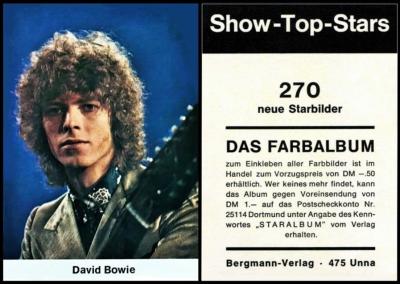
This card is generally regarded as David Bowie`s "Rookie" card, primarily because of the perm that he is sporting, which was first seen in a photo shoot, taken at his house in Beckenham, in 1969.
However our card is from a performance, and the same one (almost the same photo as well) was featured on a second set by Bergmann-Verlag,, issued in 1971 under the name of "Hit-Parade".
Some readers may be thinking it would be easy to find which appearance this was, but have a look at Bowie-World/Concerts and you will see how many there were between 1958 and 1969, and as part of many different groups. But maybe someone knows which one?
Despite the fact that David Bowie would later live in West Berlin, oddly he did not tour there right until 1976, on the Isolar Tour, by which time he was in the persona of the Thin White Duke. The tour started in Vancouver, Canada, on the 2nd of February, and the German performances were from the 7th of April (in Munich) through to the 14th of April (at Ludwigshafen).
This set was sold in shops in two formats, a clear fronted pack of ten cards, which enabled you to see the card in the front (but not the rest), and a wax pack on which the front calls the set "Star Bilder" (Star Pictures) but did not tell the number of cards which were inside. Some collectors think that the clear fronted pack came later, and contained a mixture of cards, not just ones from this set.
You can see a checklist at the Trading Card Database/BVS, which shows most of all that many of the stars featured were European, and so would have been very unfamiliar to British music fans. This probably means that cards only started to become available through swapping between friends, and then gained a wider audience with the rise of internet auctions.
Some of the cards also show that the publishers did not know that much about non-European music; and the most famous card from the set is number 190, which is titled "Jim Hendrix" (not Jimi)
Friday, 10th January 2025
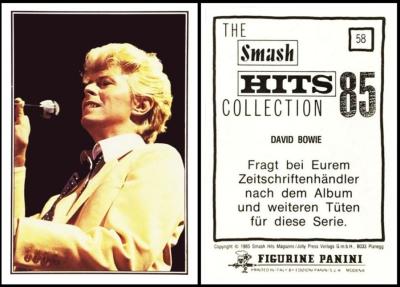
I did think that this card commemorated David Bowie`s appearance at Live Aid, on the 13th of July, 1985, at Wembley Stadium, but his costume was very slightly different, here he is sporting a dark tie not a light one.
In any event, the Live Aid performance was pretty pivotal for David Bowie, and it brought him many new fans.
The concert was along the same lines as Band Aid, a group of performers getting together to raise awareness of other people`s plight; in this case it was all organised by Bob Geldof of the Boomtown Rats and Midge Ure of Ultravox - and the money raised was for the famine in Ethiopia.
By the way, David Bowie appears twice in this set, numbers 58, our card, and 59, where he is in a suit. There are also two versions of both cards; ours, which has the reverse text in German, and another, much easier to acquire here, which has the reverse text in English.
Smash Hits was actually a magazine, a printed one, which began in 1978 as a monthly, and, die to popular demand, moved to fortnightly. It was a mixture of pin ups and lyrics. Interestingly, you could also get it in continental Europe, especially in Germany, which ties in nicely with our cards. There were also versions in French as well as, later on, for Australia and America, though that was called "Star Hits", rather than "Smash" which was felt to not suggest the contents as well as being thought a bit violent.
However it slowly lost its power, as music went online, and you could get everything you wanted on there, you were not restricted to what the publishers chose. There was also another reason, for certain "censored" lyrics and pictures were also available online.
The last issue of the magazine appeared in 2006.
I have not been able to tie up the cards with the magazine, but I do know that there were Panini Smash Hits cards from 1984 until 1987, at least. Each of these sets had special albums as well
The 1984 one seems to be the first, and it had David Bowie amongst the stars on the cover of the album. The set was published in a variety of languages, Belgian, French, and Swiss, and the French cards also seem to have been circulated in Canada. There were 144 stickers.
Our card comes from the 1985 version.
The 1986 version had more stickers, 180, and included, for the first time, sectional stickers - one group made up a large photo of Madonna and another of the performers involved in Band Aid.
The 1987 set was subtitled "An A to Z of Pop". The sectional pictures returned, of A-Ha, Nick Kamen, Madonna, and the Pet Shop Boys.There were 200 stickers.
The 1988 stickers were again a set of 200, with sectional pictures, this time A-Ha, Rick Astley, Blue Mercedes, Whitney Houston, Madonna, The Pet Shop Boys, plus Pepsi and Shirlie. This seems to have been the final year of issue.
Thanks for tuning in, as always, and thanks also to those of you who supply cards and themes, often at short notice, and also who act as sounding boards, as well as those who try to steer me away from certain events that I have a hankering to feature. And sometimes I even listen.....
I freely admit that I am often delayed because I have also gone off chasing the leads I discover and completely lost track of the time and the deadline. But we made it, more or less, and I hope you found it entertaining. More than that, I hope you found something to spark a flame to set you off on your own research.
And to read the next edition of our newsletter click here
